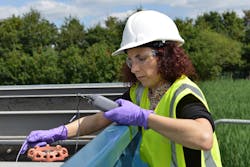Research: Mixed media improves performance, effluent quality of MBBR systems
CRANFIELD, UK, JULY 16, 2018 -- Cranfield University's Water Sciences Institute has completed a three-year research project in partnership with plastic media manufacturer Warden Biomedia, an SME based in Luton. This project investigated the influence of Warden's biomedia physical properties on moving bed biofilm systems, including mixing, oxygen mass transfer, process start-up and effluent quality during steady state operation. The aim was to improve efficiency, cost-effectiveness and sustainability of processes such as submerged aerated filters (SAF), moving bed biofilm reactors (MBBR) and integrated fixed film activated sludge (IFAS) and trickling filters. The research was completed by Dr Joana Dias under the supervision of Dr Ana Soares and Professor Tom Stephenson at Cranfield University.
Dr Ana Soares said, "Moving bed biofilm systems are traditionally designed and operated based on the carrier media surface area or protected surface area. Much attention has been given to maximising the media surface area, neglecting other physical proprieties, such as geometry, size, shape and voidage. This has lead in the development and use of media with small gaps and narrow spaces for the biofilm to develop, leading to limitations in mass transfer, especially in medium to high carbon loaded wastewater treatment plants. The right shape and appropriate gaps and voidage between internal fins of the carrier media can contribute to the improvement of effluent quality, efficiency, cost-effectiveness and overall process sustainability."
The research concluded that moving bed biofilm systems can be operated with mixed media to improve the overall performance and increase effluent quality. Organic removal can be improved by using spherical media in the first stages of the process (Warden's Biofil, Bioball, and Biomarble media), complemented with a higher protected surface area media to improve nitrification (Warden's Biopipe and Biotube media). Strong correlations were achieved between biofilm formation rates, maximum COD utilisation rate and ammonia removal rate and the Warden Biomedia products physical properties. More specifically it was clearly observed that dimensionality (Di) and voidage (Voi) were critical factors, with correlations R2= 0.92-0.95.
Commenting on the findings, Warden's Managing Director Mark Barrett, "This unique collaboration has opened up new ways of thinking that will really challenge what the water industry is doing right now. It has given us unprecedented insight which will inform alternative design approaches for the next generation of biofilm processes. As with all good research projects, it has pushed the boundaries raising further questions for which we'll be seeking answers in another phase of research later in the year."
